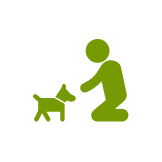In 24 cities
How the Right Play Unlocks Focus, Calm & Better Bonding
|
|
Time to read 2 min
Get product availability and delivery timelines based on your location.
No saved addresses found
Add an address to see it hereAre you sure you want to delete this address?
100% Authentic

Easy return policy

Help us ensure a smooth delivery
Help us ensure a smooth delivery
SIZE GUIDE
Written by: Dr. Shantanu Kalambi
|
|
Time to read 2 min
Playtime isn't just about burning energy—it's one of the most important tools to shape your dog's behavior, reduce stress, and build trust. When tailored to your dog’s energy level and personality, play becomes more than fun. It becomes purposeful.
In this blog, we break down different play styles, the benefits of mental vs physical stimulation, and how to match your dog’s needs to the right toys and treats.
Dogs don’t all play the same way. Recognizing your dog’s natural play behavior helps in selecting the right activities:
Dog Type |
Best Suited Play Options |
Why It Works |
High-energy runners |
Fetch toys, tug ropes, flirt poles |
Helps release pent-up physical energy |
Food-motivated thinkers |
Puzzle toys, snuffle mats, interactive feeders |
Engages the brain, prolongs mealtime |
Chewers or anxious dogs |
Durable chews, calming toys |
Offers stress relief & oral health |
Learners in training |
Training treats, basic command sessions |
Reinforces behavior, builds focus |
Dogs get bored too. Mental stimulation is as crucial as physical activity—especially for intelligent breeds like retrievers, collies, or shepherds.
Brain games help in:
Reducing destructive behaviors
Slowing down eating habits
Improving responsiveness and recall
Strengthening your dog’s attention span
Introduce food-dispensing toys, hide-and-seek games, or short training bursts between playtime to enrich your dog’s routine.
Watch out for these cues that your dog might be under-stimulated or mismatched with their current play setup:
Restlessness even after walks
Chewing or barking when alone
Ignoring toys or getting bored quickly
Trouble settling down at night
Switching up toys every few days or using rotation baskets can keep things novel and exciting.
Combine toys and treats to boost play impact. For example:
Use peanut butter inside rubber chew toys for calm chewers
Pair fetch games with recall treats
Offer training treats during tug-of-war to practice "drop it"
These small techniques help make playtime not just fun, but also rewarding and structured.
Dogs don’t just want toys—they want your attention. Interactive play not only strengthens the human-dog bond, but it also provides structure and comfort. Take time out daily—even 15 minutes of focused, active play can improve behavior and reduce separation anxiety.
Closing Thought
The right mix of physical and mental play gives your dog the balance they crave. At Supertails, we’re here to help you find tools tailored to your pup’s play personality.



In 24 cities

Happy pet parents

For every new member

Exclusive
2 item in cart
₹10,360


